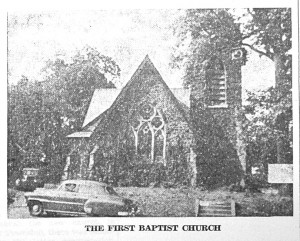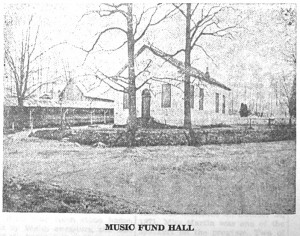The five-year-old boy standing in the doorway of his father’s hardware store on Conestoga road watched the tall bell tower of the Old Radnor Baptist Church as it came crashing down several weeks ago as part of the work of demolition of the 60-year-old edifice.
“God must be crying”, he said solemnly.
“Why?”, a bystander asked small Anthony Fillipone.
“Because they are tearing down His House”, the boy replied.
Few perhaps could express in words what Anthony had said so simply. And yet all much feel a sense of sadness at the vacant southeast corner of old Conestoga road, where it is intersected by West Wayne avenue. For 60 years one of Wayne’s largest and most stately stone churches had stood there. For 50 years before that its people had worshipped in the small building that had previously stood on this same site. Now all that remains is a great pile of stone, fallen in on the foundations of the former church. Soon even these stones will be hauled away, and the last vestige of the old Radnor Baptist Church will be wiped from the landscape.
And yet it is inevitable that this should have come to pass. The last entry in the old Church Record Book is under date of January, 1929. It is but three lines long and states simply: “After struggling along for several years now with only a handful of attendance to pay a pastor, we decided to discontinue services.”
Just a year before, the church had “received its greatest loss when two of our oldest and most loyal members answered the call of the Great Beyond”. Mrs. Sarah M. Siter was a member of the church since 1893. For many years she faithfully served as church treasurer and also on the Board of Trustees. Mrs. Mary E. Longacre, who until her death was the oldest living member of this church, died April 5th.
It was in May, 1896, only six years after the completion of their handsome new church building that a special business meeting was called “for the purpose of considering the advisability of securing a location for our Church and re-building near the center of the town”. A motion to this effect was defeated by a narrow majority of three votes.
In July, 1896, another meeting was called “by order and in behalf of the Board of Trustees.” The call to this meeting states: “The lot which we hope to procure, and which is valued at $6,000, has been offered to us for $1,500. Towards this amount, interested friends have pledged $1,000. If the Church would raise $500 we could secure the most desirable location for a church in our town.”
Again the idea of moving to a new location was rejected, this time by a slightly larger majority. Then at a meeting held early in November of 1896 at the home of one of the members a resolution was passed “to form a new Baptist Church in Wayne” and to build on a lot on Lancaster avenue, west of the Trust Company”. This is, of course, the site of the present Central Baptist Church. Those who had decided on this step asked for “the encouragement and sympathy of the entire membership of the First Church, since they believed “that the erection and maintenance of a Baptist church in a more central location would result in greatly blessing the community and the building up of the Christian life of those who hold to Baptist faith and principle.”
The tersely worded reply of those who wished to remain in the church on Conestoga road is as follows:
“We, the undersigned members of the First Baptist Church of Wayne, do agree to stay in the present church building to worship and to support it, and let those who wish to go and build a new church, go, and leave us undisturbed in the future and may God be with them.”
And so the matter was settled. Soon thereafter the Central Baptist Church was built, just west of the Wayne Title and Trust Company on a lot extending from Lancaster pike to West Wayne avenue. And for more than 30 years there were two Baptist churches in the small community of Wayne.
In view of the widespread attention entered on the demolition of the old church building, it would be interesting to know who the architect and builder were, as well as the names of the building committee and the means by which funds were raised.
But church records regarding these matters were apparently not made, or if made, were not kept in the old record book. There is, however, a record of Dedication Day of November 30, 1892, conducted by the pastor, the Rev. John Miller, when Dr. Abbott, president of the Board of Trustees “made a report of all the money and donations given in helping to pay the church debt . . . the mortgage was then burned, while the congregation joined in singing the doxology.”
Resolutions adopted on this occasion “recognize the self-sacrificing devotion and untiring energy with which our beloved Pastor, Reverend John Miller and wife, have most efficiently and successfully borne the larger share of the burden involved in the achievement in which we now rejoice.” When this writer went through the old church just before its demolition, the portraits of the Reverend and Mrs. Miller still looked down from the walls upon the deserted church which, 60 years ago, they had been instrumental in erecting. These pictures have since been placed in the rooms of the Radnor Historical Society. The big three-toned bell, presented to the church in 1890 by Mr. and Mrs. Joseph H. Childs, has been taken across Conestoga road, where it may be seen in front of the store of Louis Fillipone, new owner of the old church property. It was made by the McShane Bell Foundry of Baltimore, a firm established in 1856 and still in existence.
The old churchyard seemed very peaceful and quiet, despite the heavy traffic of Conestoga road, as the writer wandered through it on a recent afternoon. The stones bear the names of many families well-known in the annals of Wayne. The section just back of the church is the older part, while in the section beyond are the newer graves. Many of these graves were there long before 1890, when the large church replace the first small one. Deacon William Siter and his wife Emily lie side by side in one of the older lots, the former having died in 1857, the latter in 1878. There are Childs and Lewises, Pughs, Ramseys, Wilds and Rossiters, to mention but a few of the old-time family names of Wayne. A number of graves bear the G.A.R. insignia. No stone has a more touching inscription than that of “Our Sons . . . Corporal Thomas P. Davis, killed at the battle of Antietam, Sept. 17, 1862, aged 21 . . . also Sgt. Stephen S. Davis, killed at Petersburgh, Va., June 17, 1864, aged 22 years.” They were sons of Stephen and Mary Davis, early members of the church. There is also the grave of a veteran of World War I, Courtland Stilwell, of the 334th Field Artillery. It is pleasant to think that, even though the old church is but a memory, the money realized from its sale will assume perpetual care to the old graveyard.
(Conclusion)


